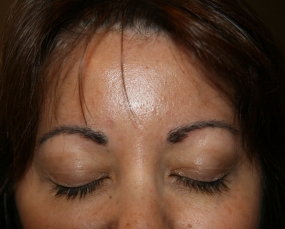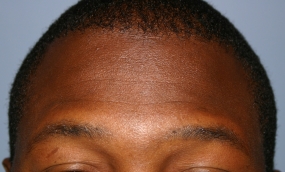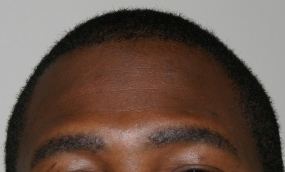Eyebrow Restoration
Eyebrows have been called the framework for one’s face. They are important for facial symmetry and balance and, for many people, offer a valuable aesthetic aspect to attractiveness. Those who are unhappy with their eyebrows may be self-conscious about their appearance, which may be reflected in a lack of confidence. Dr. Matthew Lopresti and Dr. Mary Lopresti, our experienced hair restoration surgeons, can help you restore your eyebrows with successful results.
What causes eyebrow hair loss?
Loss of eyebrow hair can occur for a number of reasons. The most common cause that our hair surgeons see is over-plucking and over-shaping. This typically occurs over a long period of time, similar to traction alopecia experienced along the hairline in women who continuously wear their hair in tight braids. The chronic pulling, plucking, and tension on the hair follicles will eventually cause them to stop growing.
Other times, eyebrow hair loss is simply genetic. Some families do not grow thick eyebrows. There are also medical causes such as thyroid disease and chronic anemia. Traumatic injury sustained from an accident, such as a motor vehicle crash, may also affect eyebrow growth. Additionally, lacerations and burns may result in scarring that makes hair growth in this area impossible. These are all common reasons seen in our practice on a regular basis.
Leonard Hair Transplant Associates’ Approach to Eyebrow Restoration
Our skilled hair restoration surgeons address hair loss in the eyebrows similarly to that of the scalp. There are three main solutions they recommend:
Medical stabilization
In regards to medication, our doctors offer two main options to slow eyebrow thinning and help the hair regrow. Although both are not approved by the FDA for eyebrows specifically, they have shown to effectively restore hair loss in the area. Our doctors believe both minoxidil, also known as Rogaine®, and bimatoprost ophthalmic solution, also known as prescription LATISSE®, can provide favorable benefits for patients unhappy with the thickness of their eyebrows.
Eyebrow Transplantation
Those who prefer a more long-term solution can opt for a hair transplant. The procedure consists of placing mostly single hair follicles, but also strategically-located grafts that are slightly larger, in the desired area. Once the single (and sometimes double) hair grafts are harvested and trimmed from the donor area, they are ready for transplantation. With this technique, the patient is asked to provide his or her idea of the shape they wish to achieve. If appropriate and realistic, one of our surgeons will mark the area and prepare it with a local anesthetic.
The surgeons will then make tiny, meticulous incisions in the treatment area, following the proper directions, angulations, and shape of the soon-to-be restored eyebrows. The grafts are then carefully planted into the incisions. The area will then be cleansed and the patient can leave the office without bandages. We will provide postoperative instructions that will help make the recovery experience as quick and comfortable as possible.
Since every patient’s goal typically is to achieve a natural look, it is important that one consults an experienced hair restoration surgeon to perform this delicate procedure. Dr. Matthew Lopresti and Dr. Mary Lopresti often recommend the avoidance of cosmetic specialists who perform eyebrow restoration but not hair restoration.
Camouflage
Following the procedure, camouflage agents such as makeup, micropigmentation (tattooing), and other cosmetic methods are helpful, but not always needed to complement the results of the procedure.
What is eyebrow restoration recovery like?
The length of the surgery will vary depending on the treatment plan, but it usually takes about 4 hours, after which you can return home. We will keep you as comfortable as possible during the procedure, and you should not experience any pain. Some soreness following your treatment may occur, although it should be tolerable. If needed, you may take some over-the-counter medication.
As with hair transplants of the scalp, the initial hairs in the grafts will grow and then fall out after approximately two to three weeks. These transplanted grafts remain empty for about three to four months. After this point, new hairs will begin to grow at a rate of about ¼ per month. In general, it takes about six months to begin to see aesthetic results, and the final results should be visible after about 18 months.
It’s important to note, harvested hairs will grow longer than native eyebrows; therefore, patients will need to trim their newly thickened eyebrow hairs to maintain the appropriate and desired length. One observation after having transplanted facial hair for decades is that the transplanted hairs can eventually take on the characteristics of the native hairs in that area and only grow to about the same length. One should not count on this phenomenon to happen, however. The human body is amazing, and each person’s experience is unique.
Schedule a Consultation
If you have thinning eyebrows and want to restore their thickness, please contact us today to schedule a consultation with Dr. Matthew Lopresti and Dr. Mary Lopresti. They are happy to answer any questions you may have concerning hair loss treatments.





